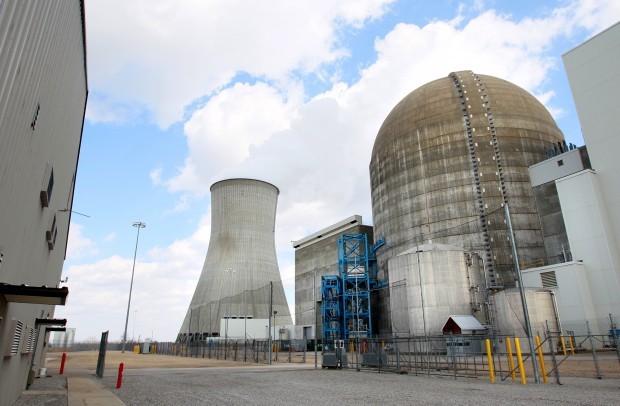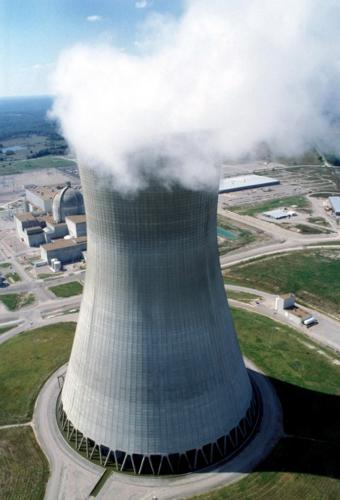Hundreds are set to gather Thursday in Columbia to attend a summit on nuclear energy ŌĆö a state-run event that aims to ŌĆ£elevate the discussionŌĆØ around how to meet the prospect of rising electricity demand while also decreasing greenhouse gas emissions.
Nuclear power could help meet both objectives and is increasingly under consideration nationally and in Missouri, nearly half a century after the last, and only, nuclear power plant was built in the state.
ŌĆ£When you put all those things together, nuclear is the only source that fills that gap,ŌĆØ said Kurt Schaefer, the director of the Missouri Department of Natural Resources, in an interview after the agency announced plans for the summit.
The Missouri Nuclear Summit also comes as recent state and federal policy changes could help set the table for nuclear power to become a bigger part of MissouriŌĆÖs energy generation future, as the stateŌĆÖs power grid ŌĆö which burns more coal than any state but Texas ŌĆö undergoes a transition and coal plants are retired.
People are also reading…
In February, Ameren announced new nuclear ambitions, with long-term plans to build nuclear generation by the 2040s. The ėŻ╠ę╩ėŲĄ-based utility currently operates the stateŌĆÖs lone nuclear plant in Callaway County, completed in the 1980s, which accounts for about 10% of MissouriŌĆÖs electricity production.
And in April, state officials from the DNR announced plans to host the upcoming nuclear summit, following a competitive, nationwide application process.
Missouri was one of seven states chosen to host such an event by the National Governors Association and the U.S. Department of Energy. The summit will feature speakers including Gov. Mike Kehoe, a range of nuclear power experts, and local officials from Callaway County.
The interest in bolstering the stateŌĆÖs generation capacity echoes concerns from utilities and others about how to meet rising energy demand from power-hungry facilities like data centers, which are proliferating in places around the country.
ŌĆ£WeŌĆÖre kind of at the beginning of a precipice where energy demand is growing really rapidly,ŌĆØ said Schaefer, of the DNR.
Nationally, booms in commercial energy usage have so far been concentrated in certain states ŌĆö with notable examples like Virginia, Texas and North Dakota. ItŌĆÖs not clear how much of a surge in electricity demand might materialize in Missouri, or how much customers of monopoly utilities, like Ameren, might be asked to pay for upgrades to the power grid largely designed to accommodate heavy users.

ėŻ╠ę╩ėŲĄ-based Ameren Missouri operates the Callaway Nuclear Plant in Callaway County near Fulton, Mo. The plant is Missouri's only commercial nuclear-fired power plant. Image courtesy Ameren Missouri
And now, fresh policy changes from Washington and Jefferson City could shape ŌĆö and complicate ŌĆö questions about what comes next, and what type of energy generation utilities will pursue.
For example, tax breaks for the countryŌĆÖs predominant forms of new generation ŌĆö wind and solar projects ŌĆö will come to a halt over the next couple of years, thanks to the massive spending bill passed this month by Congressional Republicans and signed by President Donald Trump.
Solar currently represents most of the new power generation projects added to the grid in the U.S. Because they still offer cheap power and are comparatively quick to deploy, experts say that renewable energy projects will still be built, but soon at higher costs to customers.
ŌĆ£To meet that need, theyŌĆÖre still gonna build a lot of wind, solar and batteries, because thatŌĆÖs what can be built in one to two years,ŌĆØ said Sam Krasnow, a senior strategist in the federal energy program for the Natural Resources Defense Council. ŌĆ£This will be a shockwave to peopleŌĆÖs energy bills, because many projects will still go forward, but just at a higher cost to everyday people.ŌĆØ
Nuclear energy, though, is one area where the purse strings were not generally tightened in the recent spending package, and where tax breaks were preserved.
Meanwhile, policies out of Jefferson City could also make nuclear power a more enticing option to utilities than it had been. A controversial bill signed this year by Kehoe enacted a practice called ŌĆ£Construction Work In Progress,ŌĆØ or CWIP, that enables Missouri utilities to collect money from customers to pay for projects before they are completed and operating.
Such a policy could be especially relevant, and risky, if applied to big projects like nuclear plants, which can be expensive and difficult to complete. In 2023, for instance, a new nuclear plant in Georgia was finished , bringing its overall price tag above $30 billion and marking the first time in decades that U.S. reactors were built from scratch.
Schaefer says that costs and the traditionally long lag time to get a nuclear plant ŌĆ£off the groundŌĆØ are key obstacles that he wants the state to examine.
ŌĆ£Financing is always an issue when youŌĆÖre looking at nuclear,ŌĆØ he said. ŌĆ£In the long run, nuclear makes a lot of sense. In the short term, it is expensive to get started.ŌĆØ
If it materializes at all, itŌĆÖs unclear which direction nuclear development could go in Missouri, whether it comes in the form of large, conventional plants or smaller ones with new technology, called ŌĆ£small modular reactors,ŌĆØ or SMRs.
When it announced its rekindled nuclear ambitions in February, for instance, Ameren said it was not yet committed to either approach, and that it has time to watch the development of SMRs, as it evaluates its options.
ŌĆ£I would think that all of these things are on the table for discussion,ŌĆØ said Schaefer.
Post-Dispatch photographers capture tens of thousands of images every year. See some of their best work that was either taken in June 2025 in this video. Edited by Jenna Jones.
















